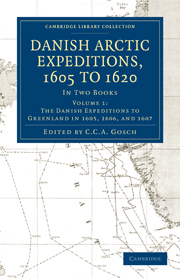Book contents
- Frontmatter
- Contents
- LIST OF MAPS IN BOOK I
- EDITOR'S PREFACE
- THE DANISH EXPEDITIONS TO GREENLAND, IN 1605, 1606, AND 1607; TO WHICH IS ADDED CAPTAIN JAMES HALL'S VOYAGE TO GREENLAND IN 1612
- INTRODUCTION
- EXPEDITIONS TO GREENLAND, 1605, 1606, 1607, and 1612
- APPENDICES
- Appendix A On the “Stockholm Chart”
- Appendix B On “Busse Island”
- INDEX
Appendix B - On “Busse Island”
Published online by Cambridge University Press: 05 December 2011
- Frontmatter
- Contents
- LIST OF MAPS IN BOOK I
- EDITOR'S PREFACE
- THE DANISH EXPEDITIONS TO GREENLAND, IN 1605, 1606, AND 1607; TO WHICH IS ADDED CAPTAIN JAMES HALL'S VOYAGE TO GREENLAND IN 1612
- INTRODUCTION
- EXPEDITIONS TO GREENLAND, 1605, 1606, 1607, and 1612
- APPENDICES
- Appendix A On the “Stockholm Chart”
- Appendix B On “Busse Island”
- INDEX
Summary
ON our very earliest charts upon which the northern portion of the Atlantic is depicted, there were shown several islands which certainly do not now exist (if they ever did so), and which are, therefore, commonly regarded as wholly mythical. The four principal of these islands were those which bore the names of Antillia, Seven Cities, Brazil, and St. Brandan.
It is manifestly difficult to prove a negative, and several centuries elapsed before geographical knowledge had advanced sufficiently for geographers to be able definitely to establish the non-existence of these islands. As was the case with many similar errors, cartographers in early days often found themselves face to face with the alternative, either to omit altogether features which were represented on earlier charts or referred to in old books, or to insert them on very insufficient evidence. The former they generally hesitated to do, lest their charts might be thought imperfect. Once inserted, therefore, mythical islands or other misconceptions often, in early days, remained long on the maps, for voyages of discovery were very few and far between, and opportunities for really trustworthy verification were correspondingly rare.
So far as the Atlantic is concerned, the islands in question remained long upon the charts because, until America had become more or less settled with Europeans, that ocean remained only very partially explored.
- Type
- Chapter
- Information
- Danish Arctic Expeditions, 1605 to 1620In Two Books, pp. 164 - 202Publisher: Cambridge University PressPrint publication year: 2010First published in: 1897



